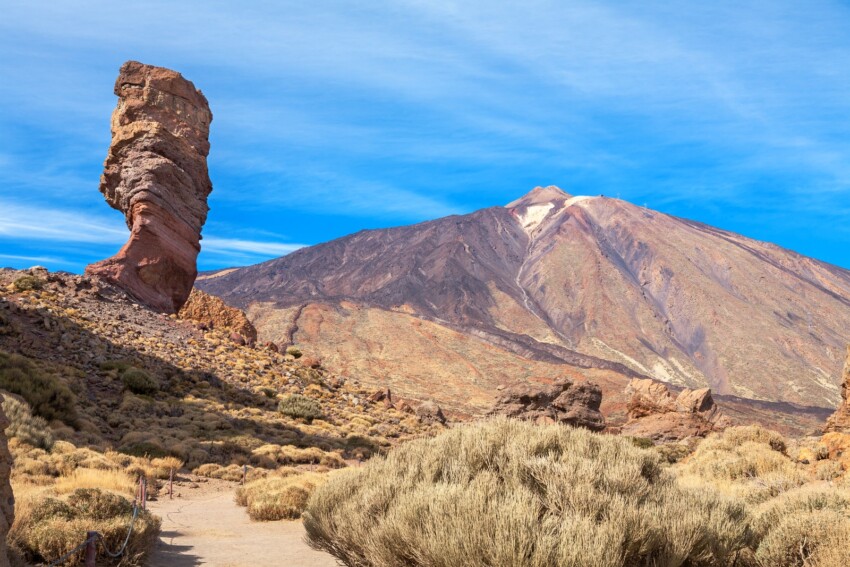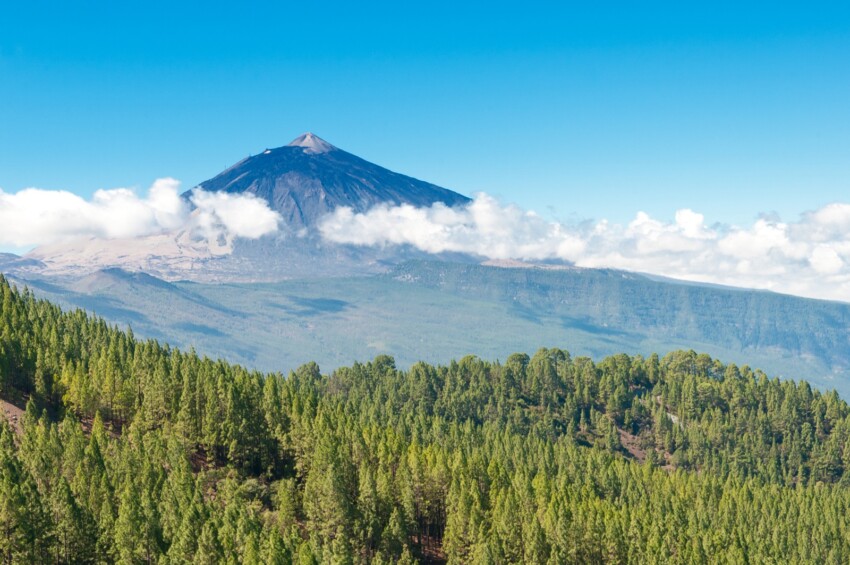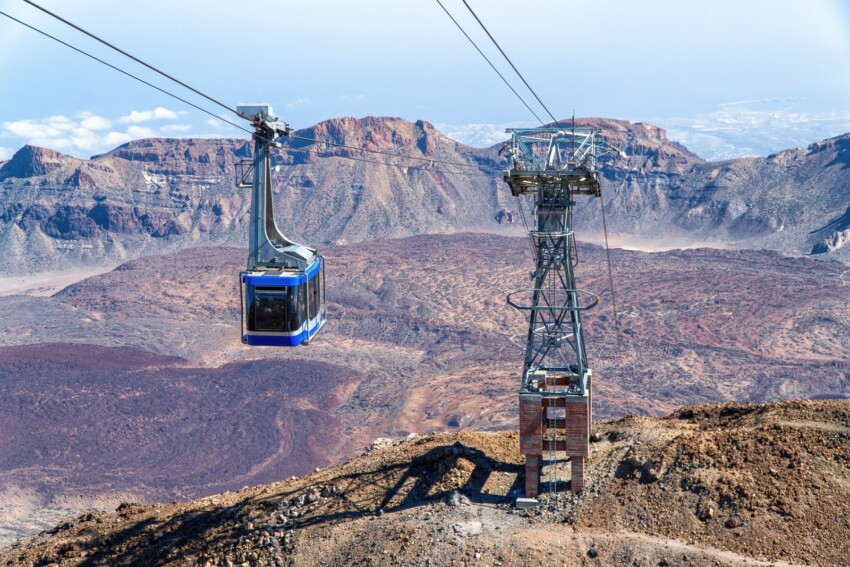
Mount Teide, or Pico del Teide as it is commonly called in Spanish, is a volcano in Tenerife, whose height of 3718 metres makes it the highest mountain in Spain. The presence of Teide makes Tenerife the tenth highest island in the world.
Teide, which was a place of prayer and pilgrimage for the island’s ancient inhabitants, is an active volcano: its most recent eruption occurred in 1909. The mountain and its surroundings are now part of the Teide National Park, which with its area of almost 19,000 hectares and its unique appearance was declared a UNESCO World Heritage Site on 28 June 2007.

The park, located within the municipality of La Orotava, is the most visited in Europe, and in 2015 it was the eighth most visited national park in the world, with over 3 million visitors. In 2016 it did even better, with just over 4 million visitors.
Inside, apart from Mount Teide, of course, there is also Pico Viejo, the second highest volcano in the Canaries, at 3135 metres above sea level.
The flora that can be admired in this area of Tenerife is unique. The interior of the Las Canadas caldera provides an ideal refuge for endemic species such as the Canary Island cedar and the Canary Island pine.
However, the species most present within the park are the white broom, which has white and pink flowers. There are also ersynium and daisies, as well as the Teide violet, which can be found practically on top of the volcano.
To get to Teide National Park , we recommend that you rent a car and follow these directions: from the north, simply follow the TF-21 road from La Orotava to Portillo della Villa. From the south, follow the TF-21 from Vilaflor or the TF-38 from Boca de Tauce to Chio, which then connects to the TF-38.
If you are near Santa Cruz or La Laguna, take the TF-24 from La Laguna to Portillo de la Villa, which then rejoins the TF-21.
Public transport is also available to reach the national park. From Puerto de la Cruz, bus number 348 departs daily at 9.15 a.m., stopping at La Orotava, Montana Blanca and reaching the departure station of the Teide cable car, before leaving for Puerto de la Cruz at 4 p.m.
From Playa de Las Americas, bus number 342 departs at 9.15 a.m., stopping in Los Cristianos and reaching the cable car departure station, before leaving again at 3.30 p.m.
The easiest way to visit Teide is with a guided tour that includes the cable car ticket and perhaps a transfer from your holiday resort in Tenerife. Of the many on offer, the following is the one most purchased by tourists and reviewed by tourists.
Alternatively, choose one of the guided tours below.

To reach the top of the mountain you can of course walk the long path, but for those not too tired, you can take the cable car, which takes you to an altitude of 3550 metres.
From there, it is possible to reach the summit of Teide by following the Telesforo Bravo path, up to an altitude of 3718 metres. To walk this path, however, you need to apply for a permit from the Teide National Park. To do so, follow this link and proceed with the free registration, but you should plan your visit a few months in advance as places are limited each day.
The cable car consists of two cabins with a maximum capacity of 44 passengers. The ride to the top of Teide takes about 8 minutes.
Cable car tickets can be purchased at the ticket offices or online, to avoid queues at the ticket office. It is possible to book the boarding time for a specific date, while at the ticket office the ticket for the first available time slot during the day will be issued.
It is advisable to proceed with the online booking, as due to the crowds, in high season it is possible to wait even several hours before being able to take the cable car.
The cable car operates daily from 9 a.m. to 5 p.m. Between 1 July and 10 September, the hours are extended from 9 a.m. to 6 p.m., with last access at 4 p.m. (6 p.m. during the summer).
It should be noted that the maximum time allowed at the upper station is one hour.
The bottom station of the cable car is easily accessible from the road, and there is a relaxation area, a bar and a buffet restaurant. There is also an information office where you can ask for advice on the various routes to take.
The mountain station, on the other hand, has wi-fi internet connection, public toilets and the highest public telephone in Spain. There is no bar, but there are vending machines for food and drinks.
The more experienced can climb to the summit of Teide on foot, following the path from Montana Blanca. It is possible to proceed independently or with the help of a guide, in which case there is no need to apply for a special permit to access the crater.
The path, which coincides with the historical ascent route to Teide, starts in Montana Blanca, at an altitude of 2320 metres, and along the route you can admire lava and pumice stone paths, until you reach the Altavista refuge at 3260 metres. From there, one reaches the arrival station of the Teide cable car at 3550 metres, following a path of solidified lava.
Finally, the last section of the path leads to the crater of Teide, the final summit at 3718 metres, from where one can admire a sensational panorama that will amply repay the efforts made for the ascent.
From the summit of Teide it is then possible to reach two viewpoints:
By far the most convenient accommodation for sleeping on Mount Teide is Parador de Las Cañadas del Teide, directly inside the national park. We are still at an altitude of 200 metres, so there is a long way to go to get to the summit, but its location is truly unique. Other amenities include the seasonal swimming pool , the two telescopes for stargazing in the evenings, and the restaurant serving Canarian cuisine.
If your budget does not allow it, you will have to move away from the national park. In the south you can choose to sleep in the area of Guia de Isora, where the TF-38 road to Teide starts from the south, while on the other side of Tenerife the best compromise is to sleep in La Orotava, where the TF-21 road to the national park starts from the north.
Teide is located in the geographical centre of the island of Tenerife, within the Parque Nacional del Teide, about 60 kilometres from both the north(Santa Cruz de Tenerife) and the south(Los Cristianos).